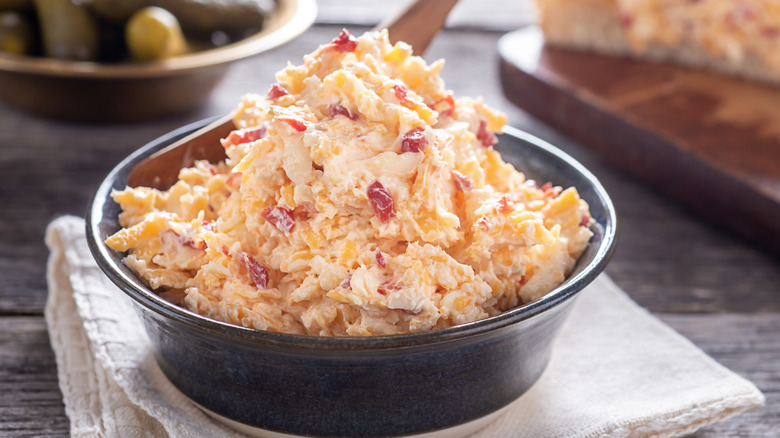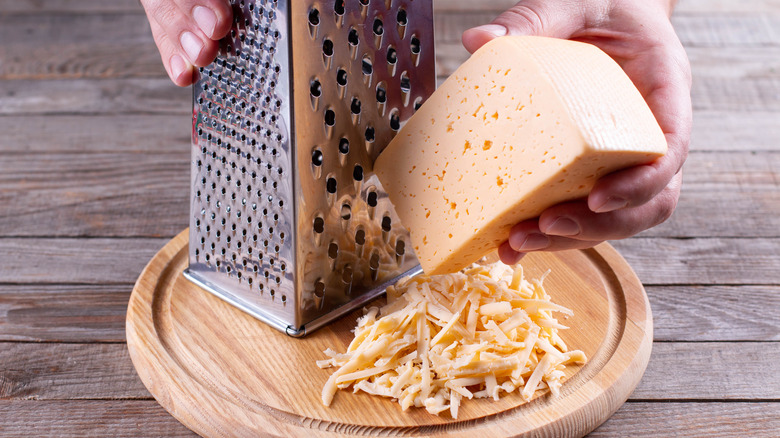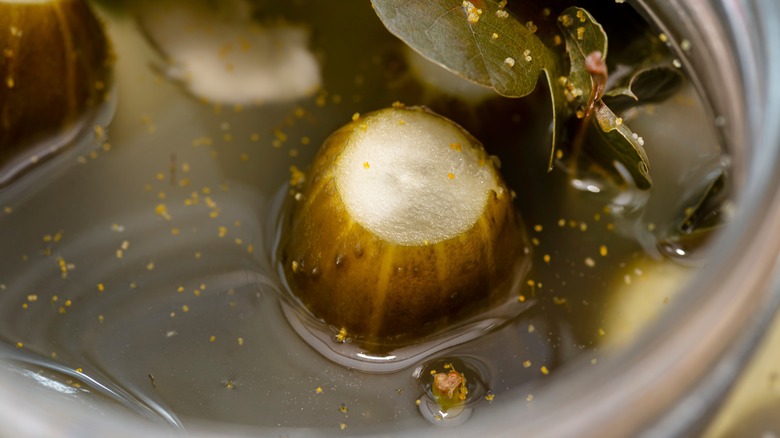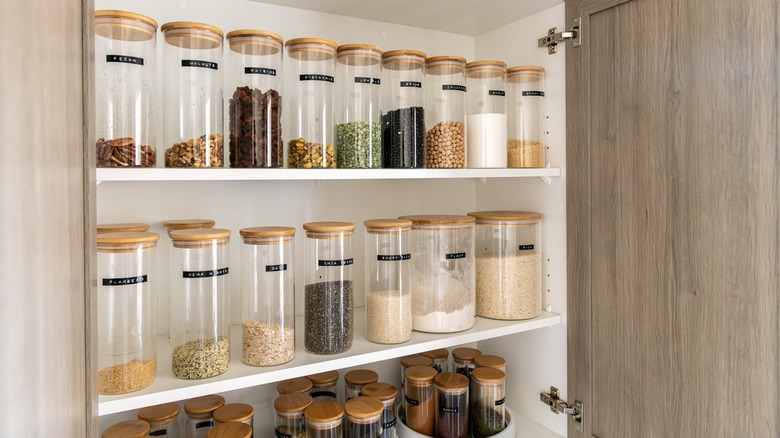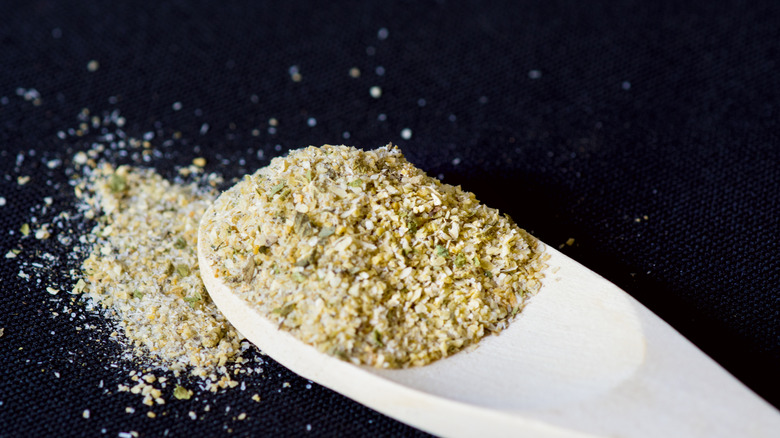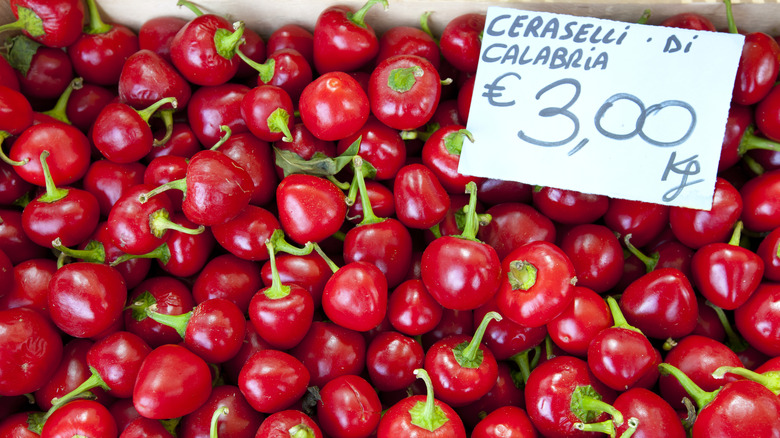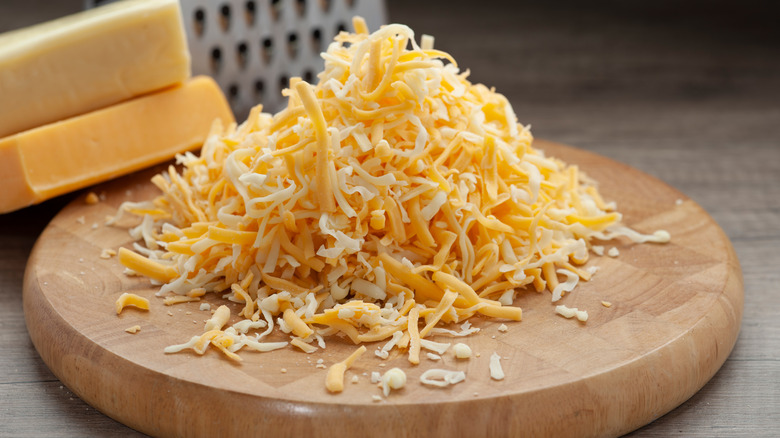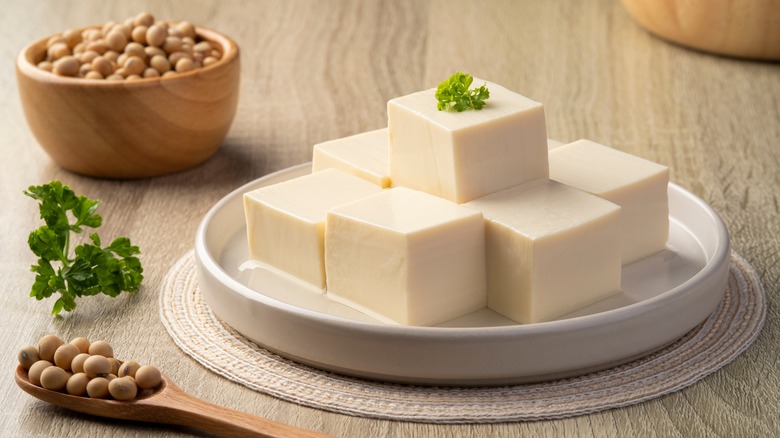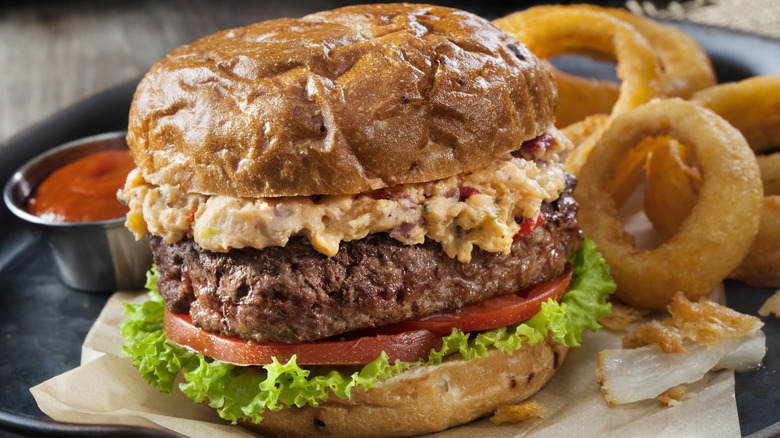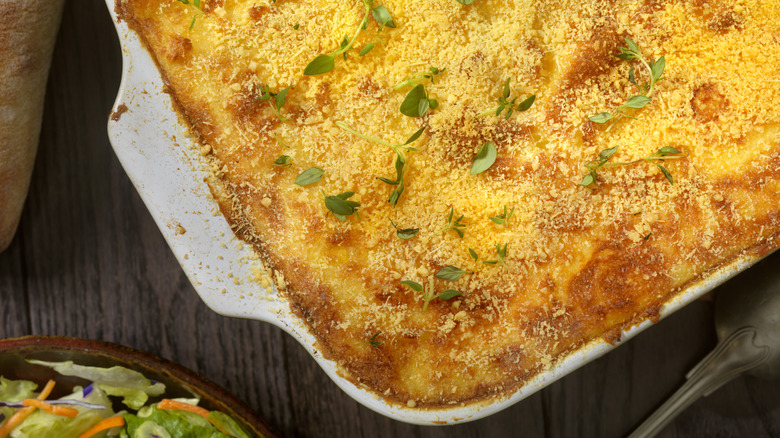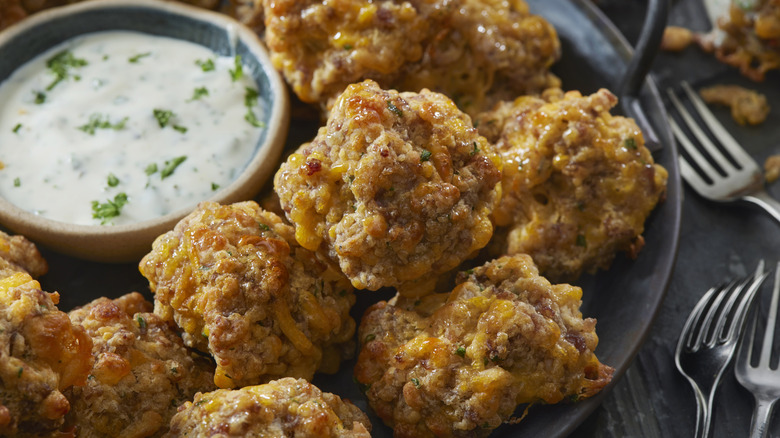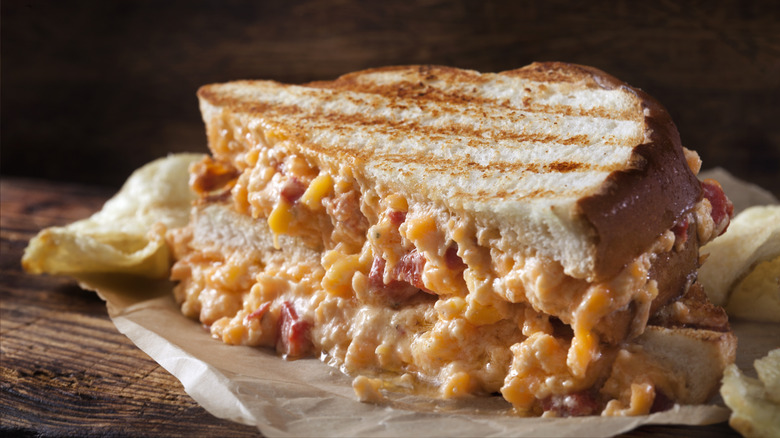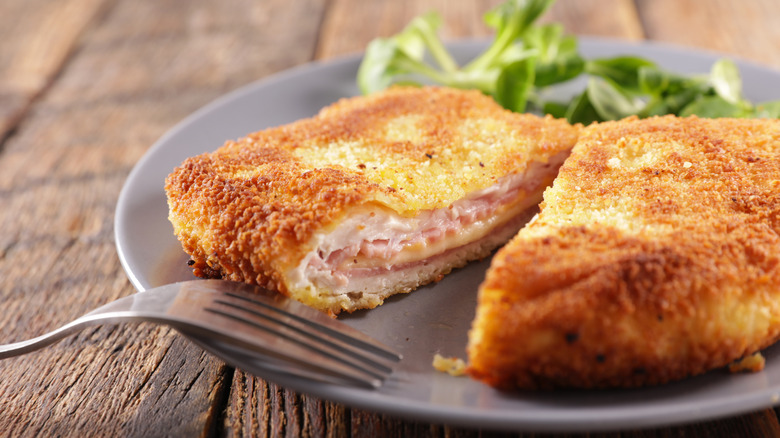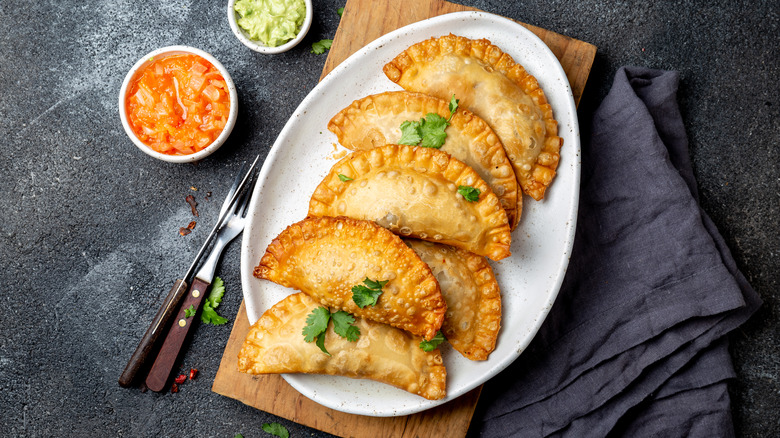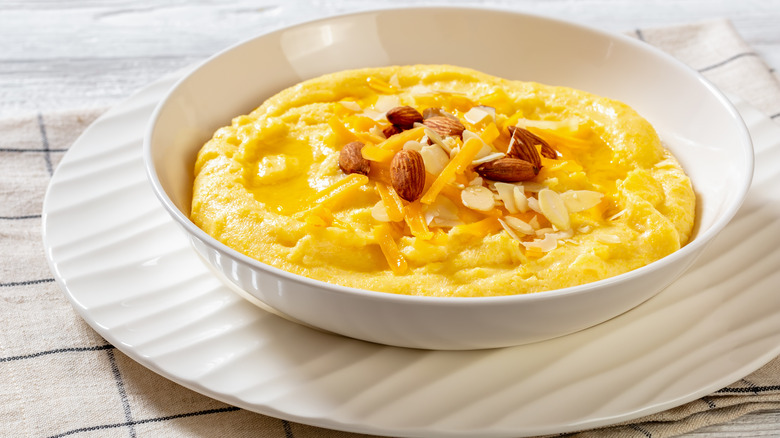14 Creative Ways To Use And Upgrade Pimento Cheese
Maybe you're from the South and grew up regularly eating pimento cheese on sandwiches, crackers, and straight from the bowl. Perhaps you came across this regional delicacy during your travels, or maybe it first came to your attention via the Masters Tournament, where pimento cheese sandwiches are the stuff of legend. Whatever the case, you've fallen hard and fallen fast for pimento cheese, in all its cheesy, tangy glory.
And if you've never even heard of pimento cheese before, you're missing out. This is a simple, no-cook recipe you need to add to your sandwich repertoire ASAP. A typical pimento cheese recipe combines mayonnaise, cream cheese (some will argue with you on the cream cheese), cheddar cheese, diced pimentos, and a few extra ingredients for flavor. It's in the same category as an egg salad and is similarly oh-so-simple and best enjoyed just as simply: between two slices of white bread. However, if you're a little tired of the simplicity, there are ways you can upgrade your pimento cheese or even use it in a few unexpected and creative ways.
1. Process or grate the cheese yourself
Tell a Southern cook that you're making your pimento cheese with pre-shredded cheddar from a bag and they'll likely clutch their pearls and give you a very backhanded "Bless your heart" once they recover from the shock. Yes, many recipes do not specify that you actually need to shred the cheese yourself, and yes, using pre-shredded cheese from a bag is much more convenient. However, if you really want to upgrade your pimento cheese, one of the easiest ways to do so is to process or grate the cheese yourself, right before you mix it with your other ingredients. Use a food processor to speed it up or a handheld cheese grater.
Why does it matter so much? It's not just because taking this extra step shows a certain dedication to the art or that the extra labor equals extra love. Instead, it's about the science. Store-bought shredded cheese contains ingredients that ensure the cheese doesn't clump together before use. While this is good for shredded cheese that you might sprinkle across your taco, it's not good when you're making a spread that ideally should have a smooth, consistent texture. If you use the pre-shredded stuff, you won't get the same creaminess, as the individual strands of shredded cheese will be doing their best not to stick together.
2. Add dill pickle juice
Most of pimento cheese's characteristic tang comes from the pimentos. (And if you're not sure what a pimento is, it's a type of pepper that's most commonly pickled before use; other than pimento cheese, it's often used to stuff olives.) However, you don't have to rely solely on your pimentos for some tang. Add in a bit of dill pickle juice, too. This unexpected ingredient will majorly upgrade your pimento cheese the next time you whip up a batch.
The pickle juice adds a little acidity that makes for a nice change. However, don't feel like you're stuck just using dill pickle juice if you want to get creative. You could use any pickle juice you have on hand (like hot pickle juice to give your pimento cheese a spicy slant). You don't need a lot though, and don't just toss it into your cheese mixture as you could inadvertently water it down. Instead, carefully measure out about a tablespoon of pickle juice, incorporate it into your mixture, and then give it a taste and adjust accordingly.
3. Add extra spices and seasonings
The great thing about pimento cheese's simplicity is that it provides you with a blank canvas on which to paint a plethora of flavors. Mayo, cream cheese, and cheddar are often paired with a variety of other components to make a range of dips, spreads, and condiments, and you can similarly tweak and customize your pimento cheese.
Don't just season your pimento cheese with salt and pepper and call it a day. Many seasonings and spices that would likely work well in pimento cheese are hanging out in your spice cabinet. Try paprika (which, by the way, is often made with pimento peppers), cayenne pepper, or chipotle pepper. If you really like the heat, add in some hot sauce. Depending on what you add to your pimento cheese, you could end up with a spicier pimento cheese, or even a smoky or Creole or Cajun-inspired pimento cheese.
4. Add garlic salt
Sometimes, you don't need to break out every option in your spice cabinet to get a great-tasting pimento cheese. Instead, harness the power of one of the most potent ingredients in your pantry, like garlic salt. Garlic salt can add a more savory layer of flavor to your pimento cheese, and if you get the proportions just right, no one will taste your pimento cheese and think it's noticeably garlicky.
No garlic salt on hand? You can make your own with just two ingredients: garlic powder and salt. Combine them at a three-to-one salt-to-garlic powder ratio and store your well-blended mixture in any empty spice jar. Then, you can use the mixture just like you would any store-bought garlic salt. If you prefer your garlic salt to be a little less salty or are watching your sodium intake, try reducing the amount of salt used by combining the garlic powder and salt at a two-to-one salt-to-garlic powder ratio.
5. Replace the pimentos with peppers
Yeah, yeah, the name is literally "pimento cheese." If you take the pimentos out and replace them with something else, is it really still pimento cheese? Well ... we won't split hairs if you don't. After all, pimentos are peppers, so if you just swap the pimentos for a different kind of pepper, you're still staying pretty close to the original idea.
Possible pimento pepper replacements include marinated roasted red bell peppers (the kind you buy in a jar), piquillo peppers, jalapeños, or diced green chiles. Depending on the pepper you choose, you'll find that your choice will slightly impact not just the dish's flavor, but the texture as well. Want to get even more creative? Keep half of the pimentos and replace the other half with another type of pepper. (Some people report you can even use sun-dried tomatoes in your pimento cheese instead as the texture is slightly similar.)
6. Grate the cheese two ways
We've already discussed the importance of using freshly grated cheddar cheese in your pimento cheese rather than pre-shredded cheese from a bag, as it makes for an overall better, creamier, and more consistent texture. However, if you're going to take the time to grate the cheese at home, you might as well take the time to grate it two ways: fine and coarse.
If you finely grate all of the cheese, you'll get a very smooth and creamy consistency, which is good. If you coarsely grate all of the cheese, you'll get a consistency that's still creamy, but with a little more texture and bite, which is also good. If you combine the two methods and grate half your cheese finely and half coarsely, you get the best of both worlds. If you've never really thought about how finely or coarsely you're grating your cheese and want to get it right, it's not that difficult to fine-tune; just use the larger holes on your handheld grater to produce a coarser texture and the smaller holes on the grater to produce a finer texture.
7. Make it vegan
If you're following a vegan diet, you may think that pimento cheese is out of your life for good. After all, it is primarily made from animal products, with mayonnaise and cheese making up the bulk of the mixture. However, savvy cooks have uncovered ways to make pimento cheese vegan, with a few ingredient swaps.
You can use firm tofu, coconut oil, and nutritional yeast, for example, in place of the mayonnaise and cream cheese. You can also go the cashew cheese route, making a vegan cheese to blend with your pimentos and seasonings. Just boil and soak cashews overnight before blending them until smooth in a food processor. Of course, the most straightforward option is to just use vegan versions of all the ingredients that you find in pimento cheese. Vegan mayonnaise, vegan cheddar cheese, and vegan cream cheese all exist, and several products are pretty close to the original thing.
8. Use it as a burger topping
If you love a burger topped with melty, gooey cheese, then you'll very likely love a burger topped with pimento cheese, too. Adding pimento cheese to your burger patty right after cooking it (be careful not to add it too soon, or it'll get a little runny) makes for a creamy, cheesy topping that also carries a little tang, thanks to the pimentos.
Of course, since the pimento cheese can stand alone flavor-wise, you don't need to add much more to your burger. Tomatoes, onions, and lettuce will all pair nicely with your pimento cheese-topped patty; you'll already have the cheese and mayo you might normally put on a burger in the pimento cheese mixture. If you added dill pickle juice to your pimento cheese, you'll have a burst of acidic pickle-y flavor as well, no need to add any hamburger chips. If you prefer succulent instead of simple, consider adding a few slices of bacon.
9. Add it to your mashed potatoes
Cheddar cheese works well in mashed potatoes. Cream cheese works well in mashed potatoes. Why wouldn't pimento cheese work well in mashed potatoes, too? After you've peeled, boiled, and cooked your potatoes, start mashing them. As they come together, add in your pimento cheese, just like you would add in cream cheese. You'll still want to add milk, cream, or whatever liquid you typically add to your mashed potatoes for a smoother consistency and texture. However, you likely won't need as much as you would if you were making plain mashed potatoes.
To ensure that all the cheese melts and the pimento cheese flavors are fully mixed into the potatoes, consider spreading the mash into a casserole dish and popping it into the oven for a few minutes. Keep in mind that you won't get a super-smooth texture when adding pimento cheese to your mashed potatoes, even if you melt the cheese thoroughly, due to the pimento chunks.
10. Make sausage balls
Sausage balls are a great little retro appetizer in the same category as cocktail wieners, and just as delightfully delicious. Modern sausage balls were popularized in the mid-1900s when Bisquik published a recipe using the brand's biscuit mix. However, some trace sausage balls all the way back to 15th-century monks, who ate a similar meatball-like concoction seasoned with cinnamon. Nowadays, a typical sausage ball recipe calls for a basic mix of ground pork, biscuit mix, and shredded cheese. Stir it all together, roll it into golf ball-sized balls, bake them, and you've got sausage balls.
However, what if you swapped the usual shredded cheese for pimento cheese? Both sausage balls and pimento cheese are staples in the South, so it just makes sense that they would work well together. The balls will have an extra punch of flavor thanks to the additional ingredients, and the cheesy mixture will produce a perfectly gooey texture.
11. Make a grilled pimento cheese sandwich
A pimento cheese sandwich has cheese, mayonnaise, and bread. A grilled cheese sandwich has cheese, bread, and for a lot of people, mayonnaise. A grilled pimento cheese sandwich is the natural next step for anyone who loves pimento cheese. All you need to do is make a grilled cheese sandwich as you normally would, but replace your cheese of choice with the pimento cheese.
Of course, you could also go extra-cheesy and use both sliced cheese and pimento cheese. If you go this route, be sure to let the sandwich cook long enough on each side to allow the pimento cheese spread to fully warm up and the cheese to thoroughly melt. Need even more flavor? Just as you might when making a pimento cheese-topped burger, consider adding bacon to your grilled pimento cheese sandwich, or toss in extra spices and seasonings for a bit more of a kick.
12. Make pimento cheese cordon bleu
If you're not really familiar with chicken cordon bleu (maybe you've heard the name before, but you've never made it or ordered it at a restaurant), the dish is pretty straightforward. Chicken cordon bleu recipes call for flattening a chicken breast; layering it with sliced ham, Swiss cheese, and mustard; rolling it all up; and then coating it in breadcrumbs before pan-frying it. The result is a layered dish that features a crispy exterior, juicy chicken in the middle, and melty cheese with piping hot ham in the center.
While chicken cordon bleu is tasty on its own, you can make a version using pimento cheese. Start by butterflying and pounding out a chicken breast until thin, just like you might when making classic chicken cordon bleu. Then, replace the dish's filling entirely with pimento cheese, before rolling the chicken, coating it in breadcrumbs, and pan-frying it.
13. Stuff it into empanadas
There's a reason that every culture has some sort of dish that's basically dough wrapped around a savory filling, and then boiled, fried, baked, or otherwise cooked until perfection: It's amazingly good. Pierogies, ravioli, dumplings, hand pies, empanadas — a version is found in every corner of the planet. As such, it shouldn't come as any surprise that someone decided to fill one of these dough-based creations with pimento cheese. For some people, the chosen vessel is an empanada.
To make pimento cheese empanadas, make your pimento cheese and empanada dough separately, then assemble them by adding just a few tablespoons of pimento cheese to each rolled and cut empanada. Fold and seal them, and then fry until golden. Don't just stop at empanadas, though. If you have another favorite from the world's vast array of dough pockets, pick your player and fill it with pimento cheese. Pimento cheese hand pies, ravioli, pierogies — the world is your oyster.
14. Add it to grits
Just like pimento cheese, grits are another great Southern food. And much like pimento cheese can be added to other Southern foods with ease (like sausage balls), so can pimento cheese be combined with grits for a dish that's pretty close to sheer perfection. Grits are a versatile ingredient that can be combined with just about anything to craft a dish only bound by your creativity. Eat them with butter. Add cheese. Use them like polenta, rice, or mashed potatoes. Top them with everything from gumbo to runny eggs.
Adding pimento cheese to your grits is about as easy as it gets. Once your grits have finished cooking, toss in a few spoonfuls of pimento cheese, mix until the cheese is heated and melty, and devour. If you don't already have the pimento cheese made, you can add the individual pimento cheese ingredients to your grits. However, note that this will result in pimento cheese-flavored grits, rather than grits topped or mixed with pimento cheese. The only noticeable difference will be the texture.
